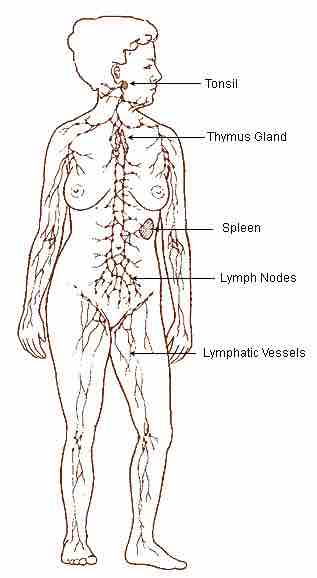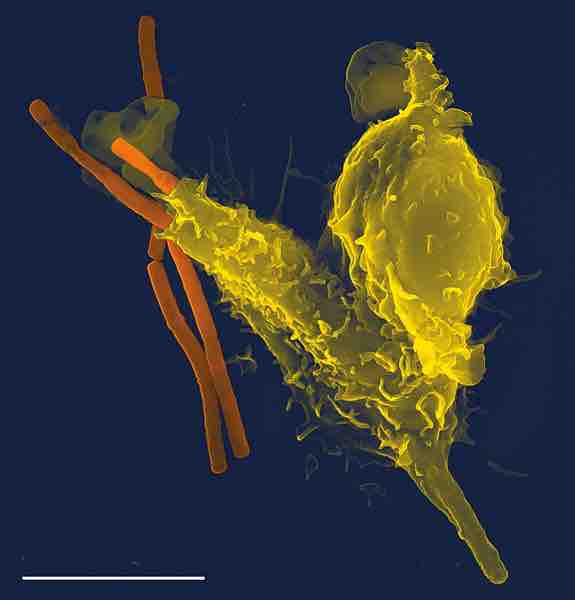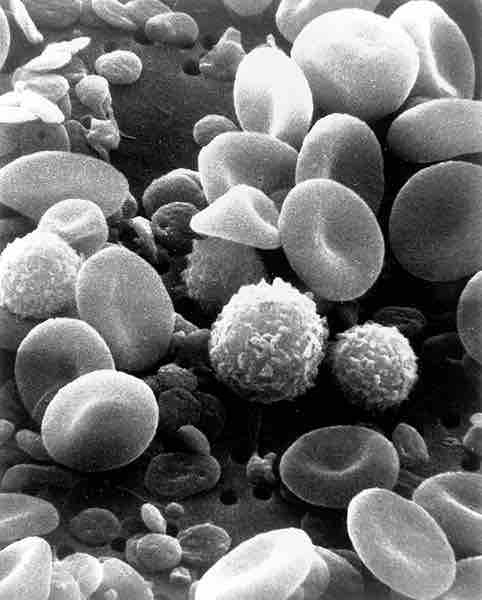Immune System Organs
The key primary lymphoid organs of the immune system include the thymus and bone marrow, as well as secondary lymphatic tissues including spleen, tonsils, lymph vessels, lymph nodes, adenoids, skin, and liver.
The thymus "educates" T cells and provides an inductive environment for the development of T cells from hematopoietic progenitor cells. The thymus is largest and most active during the neonatal and pre-adolescent periods of development. By the early teens, the thymus begins to atrophy and thymic stroma is replaced by adipose tissue. Nevertheless, residual T-lymphopoiesis continues throughout adult life.
Bone marrow is the flexible tissue found in the interior of bones. In humans, red blood cells are produced in the heads of long bones. The red bone marrow is a key element of the lymphatic system, being one of the primary lymphoid organs that generate lymphocytes from immature hematopoietic progenitor cells. Bone marrow and thymus constitute the primary lymphoid tissues involved in the production and early selection of lymphocytes.
The lymphatic system is a part of the circulatory system, comprising a network of conduits called lymphatic vessels that carry a clear fluid, called lymph, unidirectionally towards the heart. The lymphatic system has multiple interrelated functions including the transportation of white blood cells to and from the lymph nodes into the bones, and the transportation of antigen-presenting cells (such as dendritic cells) to the lymph nodes where an immune response is stimulated. Lymphoid tissue is found in many organs, particularly the lymph nodes.

The Lymph Nodes and Lymph Vessels in Human Beings
The lymphatic system is a part of the circulatory system, comprising a network of conduits called lymphatic vessels that carry a clear fluid called lymph.
The spleen is similar in structure to a large lymph node and acts primarily as a blood filter. It synthesizes antibodies in its white pulp and removes antibody-coated bacteria along with antibody-coated blood cells by way of blood and lymph node circulation.
The palatine tonsils and the nasopharyngeal tonsil are lymphoepithelial tissues located near the oropharynx and nasopharynx. These immunocompetent tissues are the immune system's first line of defense against ingested or inhaled foreign pathogens. The fundamental immunological roles of tonsils aren't yet understood.
Lymph nodes are distributed widely throughout areas of the body, including the armpit and stomach, and linked by lymphatic vessels. Lymph nodes are garrisons of B, T and other immune cells. Lymph nodes act as filters or traps for foreign particles and are important in the proper functioning of the immune system. They are packed tightly with the white blood cells, called lymphocytes and macrophages.
The skin is one of the most important parts of the body because it interfaces with the environment, and is the first line of defense from external factors, acting as an anatomical barrier from pathogens and damage between the internal and external environment in bodily defense. Langerhans cells in the skin are part of the adaptive immune system.
The liver has a wide range of functions, including immunological effects—the reticuloendothelial system of the liver contains many immunologically active cells, acting as a "sieve" for antigens carried to it via the portal system.
Immune System Cells
Leukocytes (white blood cells) are immune system cells involved in defending the body against infectious disease and foreign materials. Five different types of leukocytes exist, all produced and derived from a multipotent cell in the bone marrow known as a hematopoietic stem cell. The innate leukocytes include the phagocytes, mast cells, eosinophils, basophils, and natural killer cells. These cells identify and eliminate pathogens and are important mediators in the activation of the adaptive immune system.
Neutrophils and macrophages are phagocytes that travel throughout the body in pursuit of invading pathogens. Neutrophils are normally found in the bloodstream and are the most abundant type of phagocyte. During the acute phase of inflammation neutrophils migrate toward the site of inflammation and are usually the first cells to arrive at the scene of infection . Macrophages reside within tissues and produce a wide array of chemicals. They also act as scavengers, ridding the body of worn-out cells and other debris, and as antigen-presenting cells that activate the adaptive immune system. Dendritic cells are phagocytes in tissues that are in contact with the external environment, and are located mainly in the skin, nose, lungs, stomach, and intestines. These cells serve as a link between the bodily tissues and the innate and adaptive immune systems, as they present antigen to T-cells, one of the key cell types of the adaptive immune system.

A Phagocyte in Action
Neutrophil engulfing anthrax bacteria. Taken with a Leo 1550 scanning electron microscope. Scale bar is 5 micrometers.
Mast cells reside in connective tissues and mucous membranes, and regulate the inflammatory response. They are most often associated with allergy and anaphylaxis.
Basophils and eosinophils are related to neutrophils. They secrete chemical mediators that are involved in defending against parasites, and play a role in allergic reactions, such as asthma.
Natural killer cells are leukocytes that attack and destroy tumor cells, or cells that have been infected by viruses.
The cells of the adaptive immune system are special types of leukocytes, called lymphocytes . B cells and T cells are the major types of lymphocytes and are derived from hematopoietic stem cells in the bone marrow.

Blood Cells
Red blood cells, several white blood cells including lymphocytes, a monocyte, a neutrophil, and many small disc-shaped platelets.
T cells recognize a "non-self" target, such as a pathogen, only after antigens have been processed and presented in combination with a "self" receptor, called a major histocompatibility complex (MHC) molecule. There are two major subtypes of T cells: the killer T cell, which kills cells that are infected with viruses (and other pathogens) or are otherwise damaged or dysfunctional, and the helper T cell, which regulates both innate and adaptive immune responses and helps determine which immune responses the body makes to a particular pathogen. These cells have no cytotoxic activity and do not kill infected cells or clear pathogens directly. A third, minor subtype are the γ T cells that recognize intact antigens not bound to MHC receptors.
In contrast, the B cell antigen-specific receptor is an antibody molecule on the B cell surface, which recognizes whole pathogens without any need for antigen processing. Each lineage of B cell expresses a different antibody, so the complete set of B cell antigen receptors represent all the antibodies that the body can manufacture.